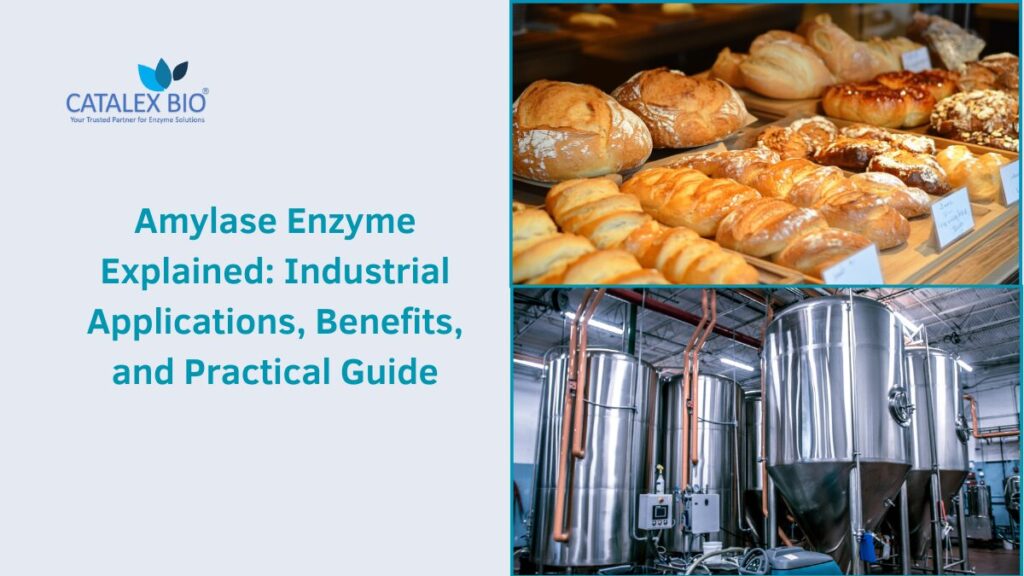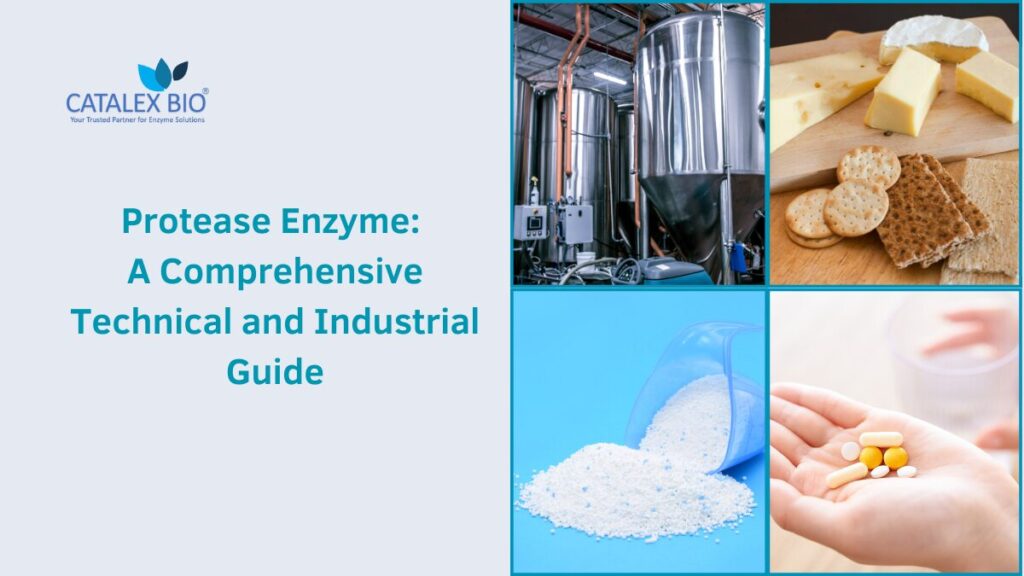Introduction
For centuries, industries across the globe have depended on harsh chemical treatments to process raw materials, manufacture products, and meet consumer demand. From the bleaching of pulp with chlorine in paper mills, to acid hydrolysis of starch for sweeteners, to the heavy use of sodium hydroxide in textile scouring—chemical-based processes became the backbone of modern industrialization. They delivered speed, scale, and efficiency, but not without consequences.
The downsides of harsh chemicals are clear: toxic effluents, high energy demands, environmental pollution, worker safety hazards, and sometimes compromised product quality. Moreover, with sustainability concerns rising and regulatory frameworks tightening, industries are under immense pressure to reduce their chemical footprint.
This is where enzymes—nature’s own catalysts—step in as game changers. Enzymes are proteins that speed up chemical reactions with unmatched specificity and efficiency. They allow reactions to occur under mild, environmentally friendly conditions. Instead of requiring boiling temperatures or strong acids, enzymes can often achieve the same (or better) results at room temperature and neutral pH.
In the last few decades, enzymes have shifted from niche applications in food to mainstream industrial biotechnology. Today, they are at the heart of green chemistry, replacing traditional reagents across food & beverage, textiles, detergents, leather, paper, biofuels, pharmaceuticals, animal feed, and more.
At Catalex Bio, we are committed to driving this transition by making high-quality industrial enzymes accessible for businesses worldwide. With a focus on sustainability, innovation, and practical solutions, we help industries move away from harsh chemical treatments and adopt enzyme-driven processes that are safer, greener, and more efficient.
The global enzyme market, valued at over USD 12 billion in 2024, is projected to grow steadily, driven by sustainability initiatives, consumer demand for eco-friendly products, and advances in biotechnology. Simply put, enzymes represent not just an alternative but the future of industrial processing.
This blog explores in detail how enzymes are replacing harsh chemicals in industry—why this transition matters, the science behind enzymes, case studies across industries, and the road ahead.
Why Replace Harsh Chemicals?
Before we understand how enzymes work, let’s look at why industries are actively searching for alternatives to traditional chemical processes.
- Environmental Concerns
- Harsh chemicals often generate toxic byproducts.
- Wastewater contaminated with acids, bases, and solvents requires costly treatment.
- Chemical processes contribute to greenhouse gas emissions and water pollution.
- Worker Safety
- Handling strong acids, alkalis, and solvents can cause burns, respiratory problems, and other health risks.
- Enzymes, being biodegradable proteins, are safer to handle when used properly.
- Energy & Cost Efficiency
- Many chemical processes demand high temperatures and pressures.
- Enzymes function effectively at moderate conditions, reducing energy costs.
- Product Quality
- Harsh chemicals can damage raw materials, leading to lower yields and compromised quality.
- Enzymes act with precision, preserving the integrity of the product.
How Enzymes Work
Enzymes are biological catalysts made of proteins. They accelerate chemical reactions by lowering the activation energy needed for the reaction to occur. Unlike harsh chemicals that act broadly and often non-selectively, enzymes work with remarkable specificity—they target a particular substrate (raw material) and convert it into desired products with minimal side reactions.
For example:
- Proteases break down proteins into peptides and amino acids.
- Amylases convert starch into simple sugars.
- Lipases hydrolyze fats and oils into glycerol and fatty acids.
This specificity means enzymes can replace chemicals that act in a less controlled manner.
Production of Industrial Enzymes
Modern enzyme production relies on microbial fermentation, often using genetically engineered microorganisms for higher yields. Enzymes can also be immobilized on solid supports, making them reusable and more stable in industrial systems.
Enzyme vs. Chemical Processes: A Comparison
| Factor | Chemical Processing | Enzymatic Processing |
| Reaction conditions | High temperature, extreme pH | Mild temperature, neutral pH |
| Selectivity | Low, many side reactions | High, substrate-specific |
| Environmental impact | Toxic waste, pollutants | Biodegradable, minimal waste |
| Safety | Hazardous | Safer for workers |
| Cost | High due to energy and waste treatment | Lower long-term costs |
| Product quality | May be damaged | High-quality, preserved integrity |
Industry-Wise Applications: How Enzymes Replace Chemicals
This is where enzymes demonstrate their true industrial value.
1. Food & Beverage Industry
The food sector was among the first to adopt enzymes at scale.
- Starch Processing
Traditionally, starch hydrolysis required strong acids at high temperatures. This often led to unwanted byproducts and required extensive neutralization.- Today, amylases, glucoamylases, and pullulanases perform this process cleanly, producing glucose, maltose, or high-fructose syrups.
- Baking
Dough conditioners once relied on chemical oxidizers like bromates. These are now restricted due to health concerns.- Enzymes like xylanases, amylases, and proteases naturally strengthen dough, improve volume, and extend shelf life.
- Dairy
Instead of acid precipitation, rennet (chymosin) is used in cheesemaking.- Lactase produces lactose-free milk, catering to lactose-intolerant consumers.
- Juices & Beverages
Acidic clarifiers once removed cloudiness. Now, pectinases and cellulases gently break down pectin and cellulose for clear, high-quality juices. - Brewing
Harsh chemicals once controlled viscosity and haze. Today, enzymes like beta-glucanase and protease manage this naturally.
2. Textile Industry
Historically one of the most chemical-intensive industries, textiles have benefited enormously from enzymatic processes.
- Bio-scouring
Traditionally done with concentrated sodium hydroxide. This consumed energy and damaged fibers.- Pectinases now remove pectins under mild conditions, preserving fiber strength.
- Bio-polishing
Harsh polishing agents are being replaced by cellulases, which remove protruding fibers, giving a smoother fabric and reducing pilling. - Denim Finishing
Stone-washing once relied on pumice stones and chlorine.- Cellulases now produce the faded look without fiber damage or stone residue.
- Bleaching Alternatives
Laccases and peroxidases are being tested as eco-friendly alternatives to peroxide and chlorine bleaching.
3. Detergent Industry
The detergent industry is perhaps the biggest commercial user of enzymes today.
- Past: Relied on phosphates, surfactants, and oxidizers to break down stains.
- Now: Multi-enzyme blends achieve the same results more sustainably:
- Proteases for protein stains (blood, sweat, food).
- Amylases for starch residues.
- Lipases for greasy stains.
- Cellulases for fabric brightness and smoothness.
By enabling washing at lower temperatures, enzymes save huge amounts of household energy globally.
4. Paper & Pulp Industry
One of the most polluting industries has also embraced enzymes.
- Chlorine bleaching has been reduced thanks to xylanases, which break down lignin-carbohydrate complexes, making bleaching easier.
- Lipases prevent pitch (resin deposits) without solvents.
- Laccases help delignify pulp, reducing the need for harsh bleaching agents.
These enzymatic methods not only reduce toxic effluents but also improve paper brightness and strength.
5. Leather Industry
Leather processing was notorious for pollution and foul-smelling effluents.
- Traditional dehairing: Sulfide-lime methods, producing toxic hydrogen sulfide gas.
- Enzymatic dehairing: Proteases gently remove hair without harmful gases.
- Degreasing: Solvents like kerosene once removed fats.
- Now, lipases break down natural fats efficiently.
- Bating: Ammonium salts and chemicals were replaced by amylases and proteases, softening hides without harmful residues.
The result: safer tanneries, reduced odor, and eco-friendly leather.
6. Biofuels & Renewable Energy
The energy sector, under pressure to decarbonize, is using enzymes extensively.
- Cellulosic ethanol: Instead of acid hydrolysis, cellulases and hemicellulases convert biomass into fermentable sugars.
- Biodiesel: Lipases catalyze transesterification of oils into biodiesel, avoiding chemical catalysts like NaOH or KOH.
- Biogas enhancement: Enzymes improve breakdown of feedstock, increasing methane yield.
These processes make renewable fuels cleaner and more viable.
7. Pharmaceuticals & Medical Applications
The pharma sector has strict requirements for purity, making enzymes ideal.
- Chiral synthesis: Enzymes create enantiomerically pure drugs without toxic catalysts.
- Wound debridement: Proteases replace chemical debriding agents.
- Green synthesis: Enzyme-catalyzed reactions minimize organic solvent use.
This not only improves safety but also ensures regulatory compliance.
8. Animal Feed
Instead of chemical treatments:
- Phytase releases bound phosphorus from phytate, reducing the need for synthetic phosphate supplements.
- Xylanases, glucanases, cellulases improve digestibility of fibers.
This makes feed more nutritious, reduces costs, and cuts down phosphate pollution from manure.
9. Other Applications
- Wastewater treatment: Enzymes degrade dyes, oils, and organic pollutants without strong oxidizers.
- Cosmetics: Enzymes replace synthetic surfactants for exfoliation and cleansing.
- Bioremediation: Enzymes like laccases break down persistent pollutants in soil and water.
Benefits of Enzyme Replacement
- Environmental Sustainability
- Lower pollution, biodegradable solutions.
- Reduction in carbon footprint.
- Cost Savings
- Reduced energy consumption.
- Lower effluent treatment costs.
- Improved Product Quality
- Higher yield, better preservation of raw materials.
- Regulatory Compliance
- Stricter laws on chemical use make enzymes attractive.
- Consumer Demand
- Enzymes enable “green” labels: eco-friendly detergents, clean-label foods, sustainable textiles.
Challenges & Limitations
- Stability: Some enzymes lose activity at extremes of temperature/pH.
- Cost: Enzymes can be more expensive upfront than bulk chemicals.
- Handling: Enzyme dust can cause allergies in workers if not controlled.
- Infrastructure: Existing facilities are designed for chemical processing.
The Future of Enzyme Technology
The future is promising, thanks to biotechnology:
- Protein engineering & directed evolution: Creating tailor-made enzymes with higher stability and efficiency.
- Immobilized enzymes: Reusable catalysts for continuous industrial processes.
- Synthetic biology: Designing microorganisms that produce multiple enzymes simultaneously.
- Circular economy: Enzymes converting waste into valuable bioproducts.
By 2035, enzymes are expected to dominate detergent, textile, and food industries while expanding into plastics degradation and waste recycling.
Conclusion
The industrial world is undergoing a profound transformation. Where once harsh chemicals defined progress, enzymes now lead a revolution in sustainable processing.
They replace corrosive acids, toxic bleaches, and energy-hungry methods with natural, precise, and eco-friendly alternatives. From clearer juices to softer fabrics, cleaner detergents to renewable fuels, enzymes are reshaping industries and aligning them with the global push toward sustainability.
Challenges remain, but innovation in biotechnology is rapidly overcoming them. The industries that embrace enzymes today not only gain a competitive edge but also secure a cleaner, safer, and more responsible future.
At Catalex Bio, we are proud to be part of this transformation by delivering reliable, high-quality enzyme solutions tailored for diverse industrial applications. If your business is ready to reduce its chemical footprint and unlock the power of biotechnology, partner with Catalex Bio today and take the next step toward sustainable growth.



